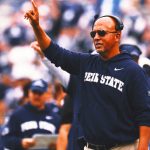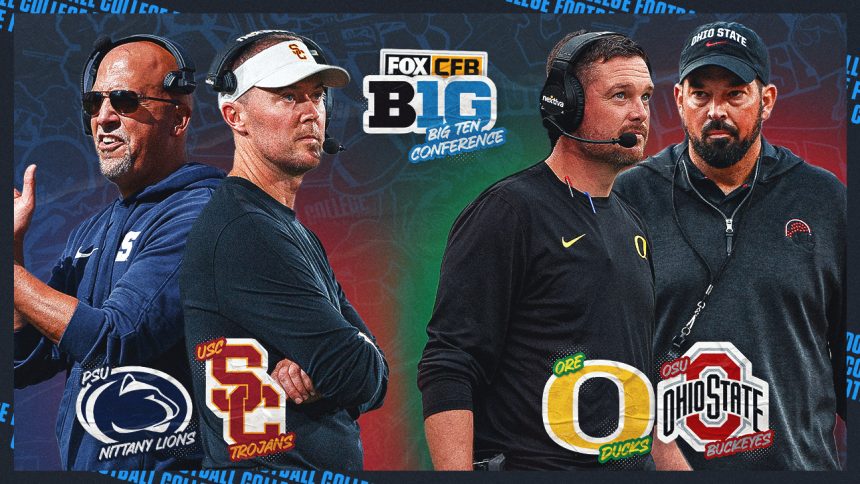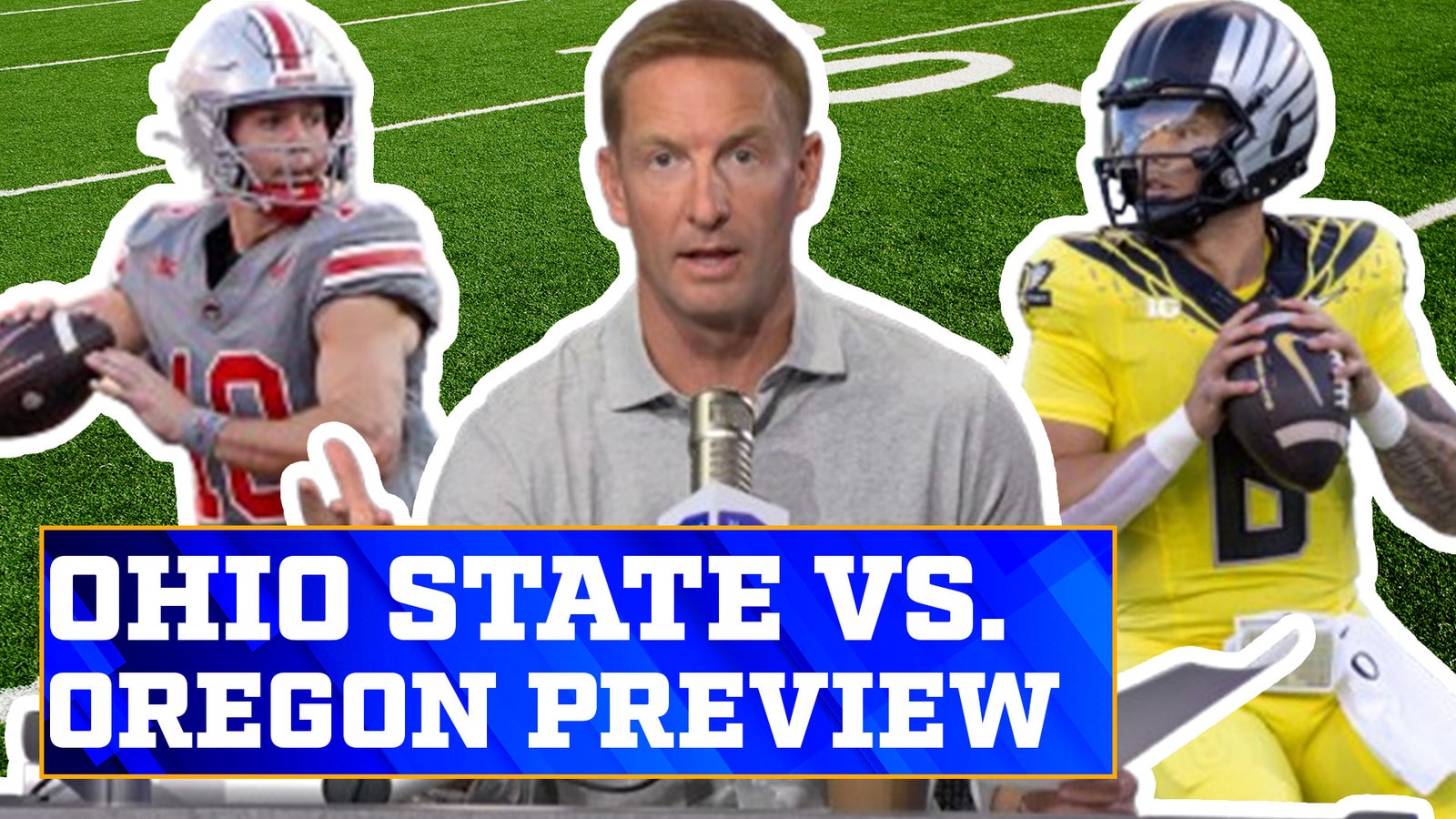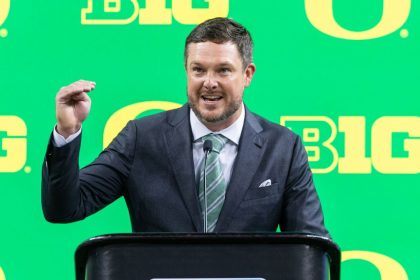Three months ago, during a three-day unofficial kickoff for the college football season at Lucas Oil Stadium in Indianapolis, a very proud commissioner flaunted the impending ubiquity of his league’s most valuable product, both in the geographic and televisual senses. Tony Petitti, leader of the Big Ten, spoke glowingly about the seven-year, $8 billion media rights deal that, when paired with a dash of West Coast expansion, would stretch the conference’s footprint from one coast to the other, from the fringes of New York City to the Hollywood Sign in California, from the outskirts of Washington, D.C., to the Space Needle in Seattle.
That all of it would be broadcast by more networks and more platforms and in more time slots than ever before was something Petitti couldn’t wait to champion during his opening remarks at Big Ten Media Days, which doubled as the unofficial unveiling of newcomers USC, UCLA, Oregon and Washington, all formerly of the Pac-12.
[College Football Playoff predictions: Big Ten, SEC dominate field]
“This year,” Petitti said in late July, “Big Ten teams will appear on broadcast networks more than 60 times, the most in college football. Fans will watch Big Ten football on FOX on Friday nights and Saturday at noon, on CBS at 3:30 [p.m.] and on NBC at 7:30 [p.m.], in addition to an array of games airing exclusively on the Big Ten Network, FS1 and Peacock.
ADVERTISEMENT
“Our new lineup has more premiere matchups week to week than ever before: Ohio State at Oregon, Penn State at USC, Washington at Iowa. And that’s just on Oct. 12. All in addition to the Big Ten rivalries our fans have come to know and love.”
Fast-forward to the present and the weekend Petitti and his fellow conference executives had been dreaming about has nearly arrived. On Friday night, Maryland will host Northwestern in a nationally televised game on FS1 (it slated for FOX until the Padres–Dodgers MLB playoff series went to a Game 5) during the network’s newly created broadcast window that debuted earlier this season.
And then on Saturday, amid a cavalcade of excellent college football games across the country, the Big Ten lays claim to two of the biggest: No. 4 Penn State (5-0, 2-0 Big Ten) traveling to the Los Angeles Memorial Coliseum to battle USC (3-2, 1-2 Big Ten), a team that is one goal-line sneak away from being ranked in the top 10, during a 3:30 p.m. EST time slot traditionally dominated by the SEC; and No. 2 Ohio State (5-0, 2-0 Big Ten) traveling to Autzen Stadium for a primetime 7:30 p.m. EST showdown with No. 3 Oregon (5-0, 2-0 Big Ten) that some believe will be a preview of this year’s conference title game back in Indianapolis at Lucas Oil Stadium, if not the national championship in Atlanta.
Toss in a noon EST kickoff between Washington, which is coming off an emotional win over then-No. 10 Michigan, and Iowa, which boasts one of the most unique home atmospheres in the country, and fans of the Big Ten have viewing options from midday through midnight on the East Coast and sunup to sundown on the West Coast — all of which are on the major broadcast networks.
“This season will be our first with a full slate of games on three broadcast networks,” Petitti said. “Along with cable and direct-to-consumer options [that provide] fans with the ability to watch Big Ten football in multiple ways.”
Once the television and scheduling components were finalized, the next step in bringing the Big Ten’s vision to life was for the individual programs to devise travel schedules for transporting hundreds of humans and equipment from one side of the country to the other far more frequently than before, when conferences still reflected regionality. An endeavor that has become common practice for football teams in the NFL is far more complicated at the collegiate level, where roster sizes are doubled — or even tripled when counting walk-ons — and academics are still supposed to be factored into the equation, though the proliferation of online classes during the COVID-19 pandemic certainly helps.
Those conversations were especially prominent during media sessions at Ohio State and Penn State this week as players and coaches were asked about the potential challenges of traveling more than two time zones for a football game. For the Buckeyes, who can enjoy the benefits of having the nation’s 50th-busiest airport in the country right there in Columbus, head coach Ryan Day repeatedly described the journey as only being “a couple hours farther than Nebraska,” and downplayed the idea that a longer flight would influence his team’s performance. Ohio State will travel on Friday, just as it always does for road games, and Day said the team has planned to continue operating on East Coast time for the duration of its stay in Oregon.
The tenor of the discussion was far different for the Nittany Lions, whose relatively remote location in the Pennsylvania mountains makes cross-country trips far more complex. Shorter runways at the State College Regional Airport prevent the largest passenger planes from flying in and out of that location due to concerns over weight and fuel. Instead, Penn State is scheduled to make the 90-minute bus trip from campus to the Harrisburg International Airport before taking off for Los Angeles on Thursday. Head coach James Franklin decided it was in the team’s best interest to travel a day earlier than normal.
“To me that’s one of the things I think we have to discuss is increasing the size of the runway here and the size of the airport,” Franklin said in a news conference earlier this week. “For a lot of reasons: for the university, for the community, for businesses, for the athletic department and for us now that we’ve decided to make this move as a Big Ten.
“Feel good about our plan, but that’s a big reason why [we are traveling a day early]. And that’s something that I think we’re going to need to look at addressing moving forward because it does change things for us compared to a lot of other teams in our conference that even if they are northeast, they have an international airport and things like that within a short distance from campus. Kind of got the double whammy. It’s the distance as well as the airport [that present challenges for us].”
What the logistics don’t change, however, is that the Big Ten’s first marquee weekend has arrived with its three best teams ranked among the top four in the country. And based on their remaining schedules from now through the end of the season — a seven-week stretch in which Ohio State, Oregon and Penn State combine to play just one top-10 opponent from the latest AP Poll — the odds of all three reaching the College Football Playoff during the first iteration of an expanded 12-team field are quite high. Even teams like No. 18 Indiana (6-0, 3-0 Big Ten) and No. 23 Illinois (4-1 overall, 1-1 Big Ten) will feel they’re still in the hunt should a fourth team in the conference make a run.
And that’s exactly the kind of platform the Big Ten dreamed of when it began to visualize just how good Oct. 12 could be.
“I think it’s great because you get to control your own destiny,” Day said at a news conference earlier this week. “Because you’re playing the best teams in the league on our schedule. So that part is great. Every time you’re playing one of these teams, you’re fighting for an opportunity to go to Indianapolis [to the Big Ten Championship game], and that’s important. And then obviously the playoff scenario.
“So there’s a lot at stake this weekend, which is exactly the way we want it.”
Michael Cohen covers college football and basketball for FOX Sports with an emphasis on the Big Ten. Follow him at @Michael_Cohen13.
[Want great stories delivered right to your inbox? Create or log in to your FOX Sports account, follow leagues, teams and players to receive a personalized newsletter daily.]
recommended

Get more from College Football Follow your favorites to get information about games, news and more











